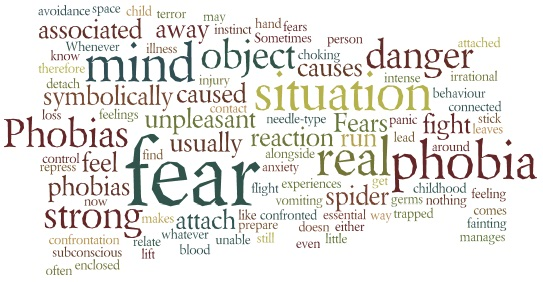A man with a spider phobia walks into a room. His phobia means that he can’t even look at a picture of something that looks like a spider without having a panic attack.
A remarkable therapist? No: this kind of thing happens all the time. Yes: the man has just experienced the Fast Phobia Cure.
WHAT EXACTLY IS THE FAST PHOBIA CURE?
The Fast Phobia Cure is probably the single most effective and reliable tool in psychotherapy today. It is reckoned to be about 90% successful on most phobias because it does what it says – it cures phobias fast.
HOW IT WORKS
The Fast Phobia Cure is a process of rapid dissociation. It allows the sufferer to experience the traumatic memories from a calm and dissociated, or disconnected, state. With the emotional tag unstuck from the phobic encounters, the phobia is de-conditioned.
It is these kinds of memories – held in the emotional part of the brain – that drive and maintain phobias. Such memories are present and so strong that just recalling them can bring on fear responses. That is, the phobic is associated into these memories so it’s almost as if they are in the situation again, experiencing similar responses – panic, pounding heart, shaking, sweating and an overwhelming desire to run.
Most of us have experienced traumatic and upsetting events in our lives. They are never pleasant memories but they don’t upset us to the extent they did at the time when we look back on these events.
When they recall their trauma, they feel pretty much the same as they did at the time it first happened, even if that was decades ago. They have vivid and affecting memories of the event.
For the rest of us, our traumatic memories are disassociated – they are more factual and carry less emotion – because they have, over time, been processed by the logical, thinking part of the mind. For the phobic, this disassociation hasn’t happened. It needs to.
THE MECHANICS
These steps are the core of the Fast Phobia Cure. They are run on the key traumatic memories around the phobia – typically three or four such memories are used – in a process that can take as little as five minutes.
It creates dissociation because the mind has never experienced the traumatic event backwards and thus has no prepared fear response for it, so they experience it in calm. The memory is recoded by the brain and saved with less emotional charge attached to it.
The way to achieve this dissociation is to have the sufferer imagine watching themselves from a remote, third person or detached position going through the traumatic event.
The classic scenario is to have them imagine themselves in a movie theater watching an old black and white movie of them going through the experience at very high speed (like watching a video on fast forward). The dissociation can be increased by having them imagine being in the projection booth watching themselves sitting in their cinema seat watching the film of their younger self going through the experience. This creates the distance and comfort for dissociation to occur.
VARIATIONS
Variations of the Fast Phobia Cure can involve changing the cinema scenario to just watching a television screen, or having them imagine witnessing the event as a bystander, from a helicopter or birds-eye view, or seeing it played out on a stage. Or, once the memory is more comfortable, having them watch a “director’s cut” by adding their own soundtrack (light or silly music is often used) and changing something about the way it looked in a humorous and creative way.
TESTING the change and measuring
The final step is to test the new responses by searching out the old trigger (going on a spider hunt with the man in the example above). The Fast Phobia Cure isn’t miraculous: it’s just based on good brain science, on current neurology.
A man with a spider phobia walks into a room. His phobia means that he can’t even look at a picture of something that looks like a spider without having a panic attack. It is reckoned to be about 90% successful on most phobias because it does what it says – it cures phobias fast. It is these kinds of memories – held in the emotional part of the brain – that drive and maintain phobias. Before, during and after the Fast Phobia Cure is run, the individual is asked to rate their level of discomfort around the traumatic memories.
Before, during and after the Fast Phobia Cure is run, the individual is asked to rate their level of discomfort around the traumatic memories. When the Fast Phobia Cure is run, very high levels of discomfort fall rapidly to zero or thereabouts. Such rapid change is often a delight and a shock to the subjects.







